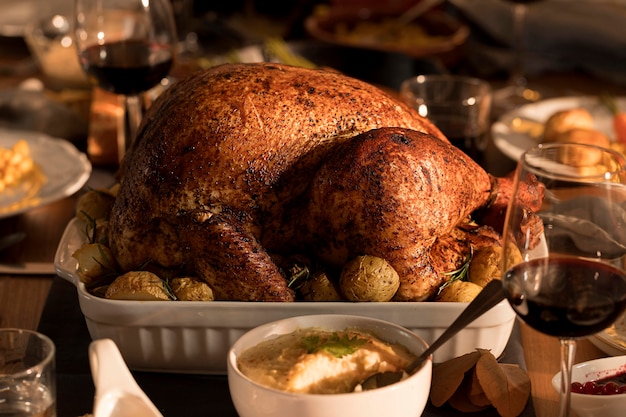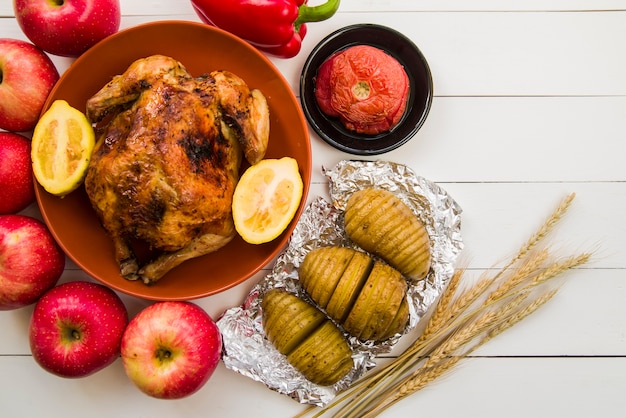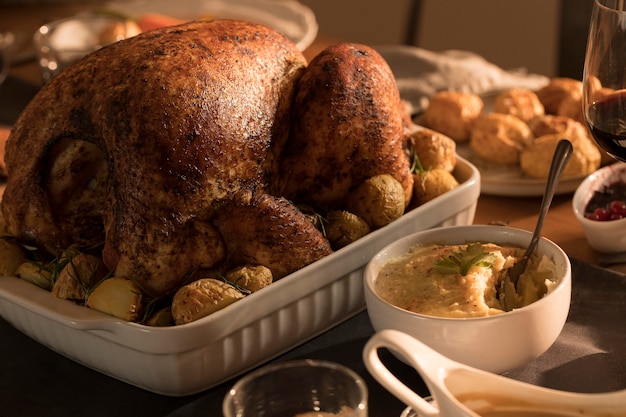(Part 1) The Basics: Understanding Turkey Size and Temperature

Let's start with the basics. A 20lb turkey is a sizable bird, and it demands respect! It's not a quick roast – it takes time to ensure the entire thing reaches the safe temperature for delicious and safe consumption.
A. The Importance of internal temperature
The gold standard for turkey cooking is reaching 165°F (74°C) in the thickest part of the thigh. This is crucial! Think of it as a scientific measurement, a guarantee that the bird is cooked through. You can't rely on just the appearance; a meat thermometer is your best friend for this job.
B. Factors Influencing cooking time
Now, let's talk about the variables that play a role in that turkey's cooking time. These are the factors you need to consider:
- Oven Temperature: High heat can cook the turkey faster, but it risks drying out the meat. The sweet spot? Between 325°F (163°C) and 350°F (177°C).
- Turkey Size: A 20lb bird is a whole different game compared to a smaller one. It takes longer to heat through, which means more patience is needed.
- Stuffing: Stuffing adds another layer of complexity, as it also needs to reach 165°F (74°C). It takes longer to cook, so if you're stuffing your turkey, plan for extra time.
- Oven Type: Every oven is different. Some are hotter, some have more even heat distribution. Your oven's personality can influence cooking time.
(Part 2) How Long To Cook A 20lb Unstuffed turkey?

Here's where the rubber meets the road. How long does it actually take to cook a 20lb unstuffed turkey? This is where the infamous "15 minutes per pound" rule comes in. But, be warned – it's just a starting point, a guideline, not a guarantee.
A. Calculating the Cooking Time
For our 20lb bird, that 15 minutes per pound translates to a whopping 300 minutes, or 5 hours. But remember, this is just a rough estimate. It's a good starting point, but the real answer is in the thermometer.
B. The Importance of Checking the Temperature
Don't be a slave to the clock! Use your meat thermometer frequently, especially towards the end of the cooking time. Trust the thermometer, not just the time. The turkey is done when the internal temperature hits 165°F (74°C) in the thickest part of the thigh.
C. Tips for Ensuring Even Cooking
Here are some tricks to help your turkey cook evenly and beautifully:
- Place the turkey on a roasting rack: This allows hot air to circulate around the bird, ensuring that it cooks evenly from all sides.
- Baste regularly: Basting with pan juices or melted butter keeps the turkey moist and flavorful. It's like a little spa treatment for your bird!
- Cover the turkey loosely with foil for the first part of cooking: This helps prevent the breast from drying out, ensuring it stays succulent.
(Part 3) The Resting Time - Don't Forget This Important Step!

Your turkey is cooked! Now, don't rush to carve it. Let it rest for at least 30 minutes, covered loosely with foil. This may seem like an unnecessary step, but it's essential for juicy, flavorful results.
A. How Long Should You Let It Rest?
For a 20lb turkey, 30 minutes is a good starting point. But consider giving it closer to an hour. The longer the better, especially for a big bird like this.
B. Why Resting is Essential
Think of it like this: the turkey has been working hard in the oven. Resting lets those juicy, flavorful liquids redistribute throughout the meat, resulting in a succulent and tender bird when you finally carve it.
(Part 4) The Importance of Brining
Let's talk about brining, a technique that can transform your turkey from good to great. It involves soaking the turkey in a salt-water solution before cooking, making it more moist and flavorful, especially important for large birds.
A. What is Brining?
Brining is essentially a spa treatment for your turkey. You soak it in a solution of salt and water for several hours, even overnight. The salt draws moisture from the air, pulling it into the turkey, leading to a juicier, more flavorful final product.
B. Benefits of Brining
Here's why brining is a game changer:
- More Juicy: It locks in moisture, preventing that dry, overcooked turkey experience.
- Enhanced Flavor: Salt is a flavor enhancer, and brining adds a subtle saltiness to the turkey. It's like a secret ingredient!
- Even Cooking: Brining helps distribute moisture evenly, leading to more consistent cooking.
C. Brining Options
You have two main options for brining:
- Dry Brining: This involves rubbing the turkey with salt and spices and leaving it uncovered in the refrigerator for 12-24 hours. It's a simpler method, but still delivers flavorful and juicy results. It also helps to achieve crispy skin.
- Wet Brining: This involves soaking the turkey in a large container of saltwater and other flavorings. It's more time-consuming, but the results are spectacularly juicy and flavorful.
(Part 5) Different Cooking Methods for a 20lb Turkey
Now, let's explore some different approaches to cooking your 20lb turkey. Each method has its own advantages and disadvantages, so choose the one that suits your style and preferences.
A. Roasting in the Oven
This is the traditional, reliable method, and it consistently delivers delicious results. Pre-heat your oven to 325°F (163°C), place the turkey in a roasting pan, and cook until the internal temperature hits 165°F (74°C). Just remember, check the temperature regularly, especially towards the end.
B. Deep-Frying
Deep-frying is a modern method that creates a crispy, golden-brown skin and cooks the turkey faster. However, it requires a specialized deep fryer and extreme caution due to the hot oil. It's a method for experienced cooks who are confident handling hot oil.
C. Smoking
Smoking adds a unique smoky flavor, a delicious twist to your turkey. It's a longer cooking method, but it's well worth the effort for those who appreciate that smoky goodness.
(Part 6) The Importance of Choosing the Right Roasting Pan
The roasting pan plays a vital role in how your turkey cooks. You need a pan that's big enough for the bird to cook evenly, without touching the sides. A roasting rack is also crucial to allow heat to circulate and prevent the turkey from sitting in its own juices.
A. Size Matters
For a 20lb turkey, you'll need a roasting pan that is at least 18 inches wide and 12 inches deep. This gives the bird enough room to breathe and cook evenly.
B. Roasting Racks
Think of a roasting rack as a personal lift for your turkey. It elevates the bird above the bottom of the pan, allowing hot air to circulate freely, resulting in more even cooking and a crispy skin.
C. Choosing the Right Material
Roasting pans come in many materials, each with pros and cons:
- Stainless steel: Durable, versatile, and easy to clean.
- Aluminum: Lightweight, affordable, and heats up quickly.
- Cast iron: Excellent heat retention, but can be heavy.
- Glass: Allows you to watch your turkey cook, but more fragile.
(Part 7) Mastering the Art of turkey stuffing
If you're stuffing your turkey, be prepared for extra time and attention to safety. Stuffing takes longer to cook than the turkey, and it's critical to ensure it reaches 165°F (74°C) to prevent foodborne illness.
A. Stuffing and Cooking Times
When stuffing your turkey, remember that it requires extra time to cook through. Plan for an additional 30-45 minutes to ensure it reaches the safe temperature. Remember to stuff the turkey loosely, giving the stuffing room to expand during cooking. The stuffing should also be packed tightly to ensure even cooking.
B. The Importance of Temperature
Don't solely rely on the turkey's temperature to judge if the stuffing is cooked. Always check the stuffing's internal temperature with a meat thermometer. It must reach 165°F (74°C) for at least 15 minutes to be safe for consumption.
C. Stuffing Alternatives
If you're hesitant about stuffing the turkey or simply prefer a less complicated approach, try these alternatives:
- Bake separately: Cook your stuffing in a separate baking dish. This is the safest option, as you can easily check the temperature.
- Make a casserole: Combine all your stuffing ingredients in a casserole dish and bake until heated through.
(Part 8) Common Mistakes to Avoid
Now, let's talk about the pitfalls to avoid, so you can cook a flawless turkey.
A. Overcrowding the Oven
If you're cooking other dishes alongside your turkey, make sure you have enough space. Overcrowding hinders airflow, causing uneven cooking. If your oven is too crowded, consider using a second oven or cooking dishes in batches.
B. Forgetting to Rest
Don't forget that crucial resting period! It allows the juices to distribute, resulting in a juicier and tastier turkey.
C. Not Checking the Temperature Regularly
Checking the internal temperature frequently, especially towards the end of cooking, is a must. Don't assume it's done; verify it with your trusty meat thermometer.
D. Neglecting to Baste
Basting is like a little beauty treatment for your turkey. It helps keep it moist and flavorful. Don't skip this step throughout the cooking process.
(Part 9) turkey carving Tips
You've cooked your turkey to perfection, now it's time to carve it with flair! Here are some tips for carving your 20lb turkey like a pro:
A. Let the Turkey Rest
Before carving, let the turkey rest for at least 30 minutes, preferably an hour. It allows the juices to redistribute, ensuring a succulent and flavorful bird.
B. Use a Sharp Knife
A sharp knife is essential for clean, precise cuts. A carving knife with a long, thin blade is ideal for slicing through the turkey easily and smoothly.
C. Carve the Breast First
Start with the breast meat. You can cut it in half lengthwise, making it easier to slice. Then, slice the breast meat into thin slices, going against the grain for the best texture.
D. Carve the Legs
Next, separate the legs from the turkey using a carving fork to hold it steady. Cut through the joint to separate the thigh from the drumstick. Then, slice the thigh and drumstick meat into thin slices.
E. Carve the Wings
Finally, remove the wings by cutting through the joint. You can either carve the wing meat off the bone or leave it whole.
(Part 10) Serving Your Roasted Turkey
The moment has arrived! You've carved your turkey, now it's time to present it proudly. Here's how to make your turkey platter a culinary masterpiece:
A. Arrange the Meat
Place the carved turkey meat on a platter or serving dish. You can arrange it creatively, with the breast meat in the center and the legs and wings around the edges, or let your imagination run wild!
B. Serve with side dishes
Pair your roasted turkey with a delightful array of side dishes, such as mashed potatoes, gravy, cranberry sauce, stuffing, and vegetables. You can also offer a selection of sauces like cranberry sauce, gravy, and apple sauce.
C. Don't Forget the Garnish
Add a touch of elegance to your platter with some simple garnishes. Fresh herbs, citrus slices, or cranberries add a beautiful touch of color and fragrance.
(Part 11) Leftover Turkey: More Delicious Dishes
You've feasted, but your turkey journey isn't over! Leftover turkey is a treasure trove of culinary possibilities. Here are some delicious ways to use it:
A. turkey sandwiches
A classic leftover turkey option, simple yet satisfying. Sliced turkey, mayo, mustard, lettuce, tomato, and cheese – it's a quick and easy lunch or dinner.
B. turkey soup
Transform leftover turkey into a comforting and flavorful soup. Add vegetables, broth, and your favorite seasonings for a hearty meal.
C. turkey salad
Combine leftover turkey with mayonnaise, celery, onion, and other ingredients for a refreshing turkey salad. Serve it on bread, crackers, or lettuce for a light and satisfying lunch.
D. turkey pot pie
Combine leftover turkey with vegetables, gravy, and a flaky pie crust for a delicious and comforting pot pie. It's like a hug in a dish.
E. Turkey Chili
Add chopped leftover turkey to a pot of chili for a flavorful and protein-packed meal. You can add other ingredients like beans, corn, and tomatoes for a truly satisfying chili.
FAQs
Q: Can I cook a 20lb turkey in a smaller oven?
It depends on the size of your oven. If it's too small to accommodate the turkey without overcrowding it, try using a roasting rack to elevate the turkey and allow heat to circulate more evenly. However, if your oven is still too small, you might need to cook the turkey in two separate batches.
Q: What if my turkey isn't done after 5 hours?
If your turkey isn't done after 5 hours, check the internal temperature with a meat thermometer. If it hasn't reached 165°F (74°C), continue cooking for another 15-20 minutes and check the temperature again. If it's still not done, you might need to raise the oven temperature slightly. Remember to check the temperature every 15-20 minutes to ensure it's cooked through.
Q: How long can I keep a cooked turkey in the fridge?
You can keep a cooked turkey in the fridge for 3-4 days. However, for the best flavor and texture, it's best to eat it within the first 2 days. After 4 days, it will begin to dry out and lose flavor.
Q: How do I know if my turkey is overcooked?
An overcooked turkey will be dry and tough. The meat will also have a greyish hue. It's crucial to check the internal temperature regularly to avoid overcooking.
Q: Can I freeze leftover turkey?
Yes, you can freeze leftover turkey. Freeze it in airtight containers or freezer bags for up to 2-3 months. Remember that the texture may change slightly after freezing, but it's a great way to extend its lifespan.
With these tips and techniques, you're equipped to conquer your 20lb turkey and create a memorable feast for your loved ones. Happy cooking!
Everyone is watching

Prime Rib Roast Cooking Time Chart: Per Pound Guide
Cooking TipsPrime rib roast. Just the name conjures images of lavish dinners, crackling fires, and hearty laughter. It’s ...

How Long to Bake Potatoes in the Oven (Perfect Every Time)
Cooking TipsBaked potatoes are a staple in my kitchen. They're incredibly versatile, delicious, and surprisingly easy to m...

Perfect Rice Every Time: The Ultimate Guide to Cooking Rice
Cooking TipsAs a self-proclaimed foodie, I've always been a bit obsessed with rice. It's the foundation of countless cuisi...

The Ultimate Guide to Cooking Asparagus: Tips, Techniques, and Recipes
Cooking TipsAsparagus. The mere mention of this spring delicacy conjures up images of vibrant green spears, crisp and burs...

Ultimate Guide to Cooking the Perfect Thanksgiving Turkey
Cooking TipsThanksgiving. Just the word conjures up images of overflowing tables laden with delicious food, the scent of r...
